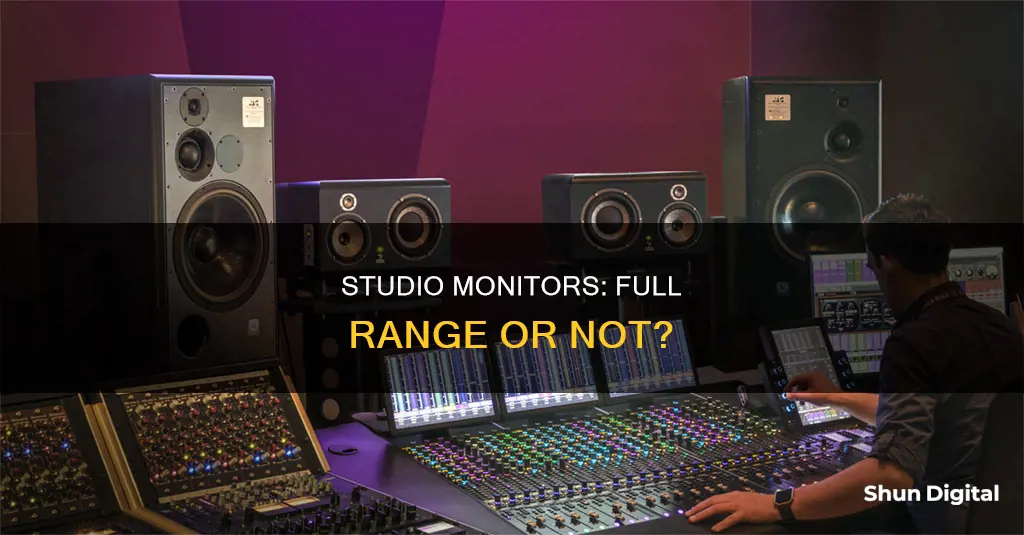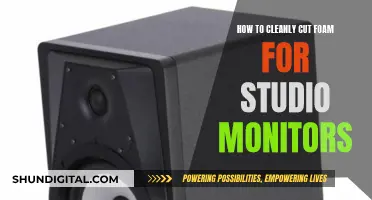
Studio monitors are an essential component of the music production process, delivering an accurate and detailed representation of the audio mix. While there is no consensus on the definition of full-range speakers, they typically aim to reproduce the entire spectrum of human hearing, from 20Hz to 20kHz. Studio monitors, with their flat frequency response and precise sound reproduction, fall into this category, providing an honest and transparent listening experience for mix engineers.
The market offers a diverse selection of studio monitors, from the renowned Yamaha HS series to the KRK Rokit line, each with its own set of features and advantages. When choosing studio monitors, considerations such as active or passive monitors, speaker size, physical dimensions, power rating, and frequency response come into play. It's important to invest in quality studio monitors and, if possible, treat your room acoustically to ensure an optimal listening environment.
What You'll Learn
- Studio monitors are designed to provide an accurate, flat frequency response
- Active studio monitors are more common than passive monitors
- Studio monitors can be nearfield or midfield
- Subwoofers are becoming more common in modern recording studios
- Studio monitor management systems make it easy to switch between sets of studio monitors

Studio monitors are designed to provide an accurate, flat frequency response
The Yamaha HS5 studio monitors, for example, are renowned for their flat frequency response, making them a popular choice among mix engineers. The HS5 monitors offer a clear and detailed sound, revealing imperfections in mixes and aiding in precision work. Similarly, the JBL 305PMKII studio monitors deliver an incredible sound for their price point, with a surprisingly good bass response for their 5" woofer size.
The KRK Rokit series is another well-known line of studio monitors that offers EQ options and Kevlar drivers, making them a favourite among electronic music producers. While the Rokit monitors may not have the flattest sound signature, their DSP-driven EQ system allows for precise sound customization to suit different room acoustics.
In addition to a flat frequency response, studio monitors also aim to provide a wide stereo sweet spot, enabling multiple people to hear an accurate representation of the audio from different positions in the room. This feature is exemplified by the JBL 305PMKII monitors, which utilise Image Control Waveguide technology to broaden the sweet spot.
Furthermore, studio monitors often include room control functions to compensate for bass buildup when placed near walls, as is common in small studios. This feature is present in both the Yamaha HS5 and JBL 305PMKII monitors, allowing users to dial in a good balance regardless of their room setup.
Overall, studio monitors are designed to provide an accurate and flat frequency response, making them essential tools for audio professionals who require honest and detailed sound reproduction for critical listening, mixing, and mastering tasks.
How Multiple Monitors Affect CPU Usage and Performance
You may want to see also

Active studio monitors are more common than passive monitors
Active studio monitors, also known as powered studio monitors, are more common than passive monitors. They feature built-in amplifiers, which means they are ready to use right out of the box. This makes them a convenient and harmonious choice for those seeking a simple setup. The built-in amplifier also streamlines cabling, reducing clutter and potential interference from multiple wires.
Active monitors often include bi-amp or tri-amp configurations, providing tailored power to each driver for precise control. Their integrated design ensures optimal performance and can enhance synergy between the amplifier and speakers. This results in improved sound quality and a more accurate frequency response.
Additionally, active monitors are typically heavier than passive monitors, which can impact mounting options. They also tend to be more expensive upfront due to the built-in amplifiers. However, they are cost-effective in the long run as no additional equipment is required.
In contrast, passive monitors require external power amplifiers, offering flexibility in customisation. Users can select and upgrade amplifiers to fine-tune their sound system. Passive monitors are generally lighter and less costly upfront but may end up being more expensive in the long run due to the need for separate equipment.
Connecting a Laptop to a Monitor: Easy Steps to Follow
You may want to see also

Studio monitors can be nearfield or midfield
Studio monitors are an essential component of the mixing process, allowing producers to hear their tracks in intricate detail and make informed decisions about EQ, compression, and other sound manipulation techniques. The market offers a wide range of studio monitors, from compact and affordable options to high-end models with advanced features.
Studio monitors can be categorised into two main types: nearfield and midfield. Nearfield monitors are designed for placement close to the listener's ears in a typical home studio setup. They generally have a smaller size, making them suitable for smaller rooms and offering a more intimate listening experience. Nearfield monitors usually have a woofer size ranging from three to eight inches, delivering adequate power and bass frequencies for most small to medium-sized rooms.
On the other hand, midfield monitors are designed to be placed at a further distance from the listener and are typically used in larger studio spaces. These monitors have larger woofer sizes, often exceeding eight inches, and provide more power and extended bass response. Midfield monitors are commonly used in professional studio environments, offering a wider stereo image and a more spacious soundstage compared to nearfield monitors.
When choosing between nearfield and midfield monitors, it is essential to consider the size of the room, the desired listening distance, and the specific requirements of the production setup. Nearfield monitors are versatile and suitable for most home studios, while midfield monitors excel in larger spaces and provide a more expansive listening experience.
OLED Monitor Buying Guide: Is It Worth It?
You may want to see also

Subwoofers are becoming more common in modern recording studios
Studio monitors are designed to provide mix engineers with accurate details to make critical mixing decisions. While regular studio monitors can reproduce some bass frequencies, subwoofers are specifically designed to handle the extreme low end of the frequency spectrum, providing powerful and precise bass responses.
Subwoofers have become increasingly common in modern recording studios, both for standard stereo mixing and for surround sound media production. Adding a studio subwoofer to a stereo pair of studio monitors allows users to monitor in 2.1 stereo, extending the low-frequency range of the monitors and allowing the low-frequency drivers to produce midrange frequencies more efficiently.
A good subwoofer can provide numerous benefits to a studio setup, including improved accuracy in bass response, increased headroom, and a more precise mix. However, it is essential to consider the space available and the target material when choosing a subwoofer. The room's acoustics also play a crucial role in achieving optimal bass performance.
When designed and used appropriately, subwoofers can be extremely effective and convenient. They enable more accurate imaging, a clearer mid-range, and higher overall output. Additionally, the compact size of subwoofers makes them easier to site and move around, which is advantageous in small home studios and location-recording rigs.
The aim when adding a subwoofer is to reproduce low frequencies accurately. This typically covers the bottom two octaves, from 20Hz to 80Hz. However, the room's acoustic properties are crucial, as even the best subwoofer will perform poorly in an acoustically poor room. Bass trapping and room treatment are essential to controlling and reducing room standing waves and achieving a well-balanced bass response.
In summary, subwoofers are becoming more common in modern recording studios due to their ability to extend the low-frequency range of studio monitors, enhance midrange frequency production, and provide numerous benefits such as improved accuracy in bass response and increased headroom.
Creative Ways to Reuse Old LCD Monitors
You may want to see also

Studio monitor management systems make it easy to switch between sets of studio monitors
Studio monitor management systems are an essential component of any studio setup, offering seamless control and flexibility over your monitoring needs. These systems allow for easy switching between different sets of studio monitors, streamlining your workflow and enhancing your creativity.
The market offers a wide range of solutions, from simple monitor switchers to advanced monitor management units, catering to diverse studio requirements and budgets. Let's explore some of the key benefits and features of these systems.
Firstly, studio monitor management systems provide a convenient way to A/B test your mixes on different sets of studio monitors. This is a common practice during the final stages of mixing, ensuring your mix translates well across various monitoring systems. With a dedicated monitor controller, you can effortlessly switch between your reference studio monitors and consumer speakers, making informed decisions about your mix.
Additionally, these systems offer advanced routing capabilities for your monitor sends, talkback system, and headphone mixes. They allow you to route all these signals through a compact desktop unit, providing easy access to different monitoring subgroups. This level of flexibility is especially useful for complex studio setups with multiple monitoring options.
Furthermore, monitor management systems come in both digital and analog varieties. Digital systems seamlessly integrate with your DAW of choice, while analog systems offer a fully analog signal path with precise control. Some units even provide digitally controlled analog routing for the best of both worlds.
When choosing a studio monitor management system, you'll find a range of options catering to different budgets and studio sizes. Desktop units, such as the Mackie Big Knob and Presonus Monitor Station V2, are ideal for home and project studios, offering a user-friendly layout and essential routing features at an affordable price.
On the other hand, rackmounted systems like the Presonus Central Station Plus are better suited for semi-pro and larger studios. They provide advanced routing capabilities and keep your setup neat by housing all the cables within your rack.
For those seeking the ultimate in monitor management, the Dangerous Music D-box+ is a top choice among high-level engineers. While it carries a high price tag, its extensive features and exceptional performance make it a best-seller.
In conclusion, studio monitor management systems are a valuable addition to any studio, offering easy switching between monitors and advanced routing options. By investing in one of these systems, you'll streamline your workflow, improve your mixing capabilities, and ultimately enhance the quality of your recordings.
Removing Lenovo Monitor Stand: A Step-by-Step Guide
You may want to see also
Frequently asked questions
Studio monitors are speakers designed for critical listening during music production and mixing. They aim to provide an accurate, transparent, and uncoloured representation of the source audio. Studio monitors are typically used by musicians, producers, and audio engineers.
Studio monitors can be classified into two main types: powered (or active) studio monitors and unpowered (or passive) studio monitors. Powered studio monitors have built-in amplifiers, while unpowered studio monitors require external amplifiers. Powered studio monitors are more common today due to their convenience and performance.
When choosing studio monitors, consider the size of the woofer, physical dimensions and weight, wattage, frequency response, and your budget. The size of the woofer affects the bass response and physical size of the monitor. Larger woofers produce deeper bass and result in larger monitors. Studio monitors with smaller woofers, such as 5" or 6" models, are often paired with subwoofers for enhanced bass response.
Studio monitors are designed to deliver a flat frequency response, ensuring an unbiased listening experience. They aim to reproduce audio without enhancing or reducing any frequencies. In contrast, regular consumer speakers often artificially boost certain frequencies, such as bass and treble, to make music sound better to most listeners. Studio monitors are used for music production and mixing, while regular speakers are typically used for casual listening.







